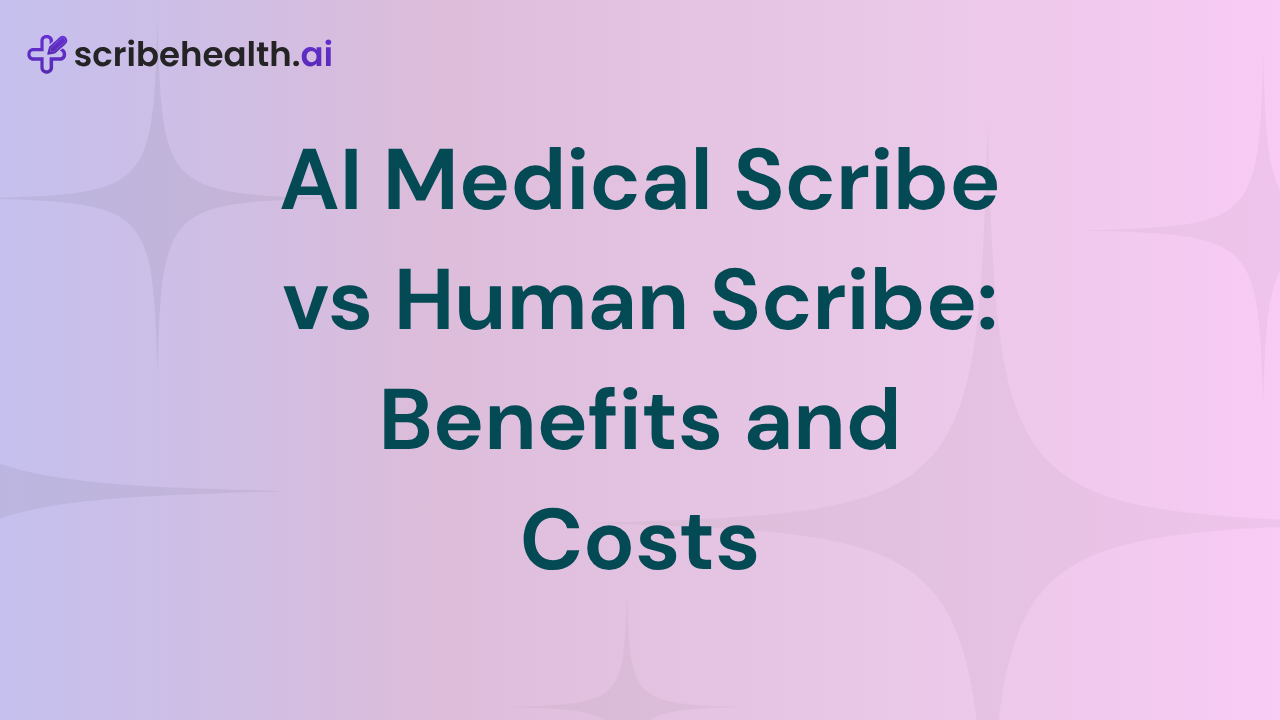AI Medical Scribe vs Human Scribe: Benefits and Costs
Physicians spend over 5.8 extra hours weekly on charting, fueling burnout and lost patient time. This guide compares an AI medical scribe with a traditional human scribe. We explore features, pricing, and workflow impact—so you can choose the solution that delivers efficiency, cost savings, and better patient focus.

Attention healthcare professionals: you already spend nearly half your clinical hours wrestling with EHRs and charting instead of caring for patients. In fact, a recent AMA report shows physicians log an extra 5.8 hours per week on documentation alone, driving burnout and eroding face-to-face time. In this post, you’ll discover whether an AI medical scribe can truly reclaim your time—or if a traditional human scribe remains the better investment.
What Is an AI Medical Scribe?
An AI medical scribe is software that listens during appointments, then uses natural language processing to create structured clinical notes. Instead of explaining care to a scribe, the doctor talks as usual, and the note appears in the EHR automatically.
Core value proposition:
- Frees doctors from typing and dictation
- Enables more focused patient interaction
- Cuts charting time dramatically
- Costs around $150–200 per provider per month
Key Features of AI Medical Scribes
- Real-time transcription—captures conversations and turns them into drafts instantly.
- Structured note formatting—applies templates like SOAP and BIRP. ScribeHealth.ai offers specialty-specific note templates for over 20 medical specialties.
- EHR integration—Works seamlessly with Epic, Cerner, Athena, etc. ScribeHealth.ai integrates seamlessly with over 35 EHR systems.
- Coding assistance—Suggests ICD‑10 and CPT codes as you go.
- Review interface—Doctors edit notes on the fly.
- Privacy built-in—HIPAA and SOC 2–compliant, with encryption.
Example:
Dr. Mehta uses an AI scribe in her pediatric clinic. After a 12-minute visit, the system drafts a complete note that only needs a quick review. That turns a 30-minute task into nearly zero.
AI Medical Scribe Pricing
AI scribes usually charge per provider per month. Here's an overview:
The Standard plan works for most independent clinics. The Pro plan suits larger practices wanting deeper analytics. Larger health systems may prefer a custom enterprise plan.
ScribeHealth provides the most affordable option, including all the premium features for just $49/month.
Traditional Human Scribes
A traditional scribe is a trained human who shadows the physician and writes notes in real-time in the exam room or outside.
Why they exist:
- Offer real-time judgment and context
- Useful for nuanced encounters or complex cases
- Have been standard in busy ERs and specialty clinics
Notable Features of Human Scribes
- Real-time contextual input—they notice nonverbal cues and clarify ambiguities.
- Flexibility—They can help schedule tests or manage clerical tasks.
- Training adapts to physician style—their notes match doctor preferences.
- Presence in-room—Can fetch charts, assist with forms, or see patient reactions.
AI Medical Scribe vs Traditional Scribe: Side-by-Side Comparison
AI Medical Scribe vs Traditional Scribe: Which One Is Right for You?
Choose AI Medical Scribe if:
- You want to cut charting time by about 1 hour per day
- You practice in multiple locations or wish to scale easily
- You need consistent pricing at $49/month with ScribeHealth.ai
- You want coding help and strong EHR automation
Choose Human Scribe if:
- You regularly handle highly complex patient cases
- You require someone to manage non-documentation tasks
- You value real-time judgment and in-room answers
AI Medical Scribe vs Traditional Scribe: FAQs
What is an AI medical scribe?
An AI medical scribe is software that records, transcribes, and structures your spoken notes into your EHR during patient visits.
Do AI scribes replace human scribes?
No. AI scribes speed up documentation, but human oversight remains critical.
How much does an AI scribe cost?
AI scribes cost roughly $150–200 per provider per month. Traditional human scribes range from $32,000–50,000 per year. ScribeHealth.ai costs just $49 per month.
Are AI scribes accurate?
Yes. Studies show 95–98% accuracy. Physicians still need to review for any errors.
Can AI scribes work with any EHR?
Most major systems like Epic, Cerner, Athena are supported via APIs. ScribeHealth.ai integrates seamlessly with over 35 EHR systems.
Is patient privacy safe with AI scribes?
Yes, they're HIPAA-compliant and SOC 2-compliant with encryption. But patients should provide consent before use.
AI Medical Scribe vs Traditional Scribe: Conclusion
Both AI and human scribes aim to reduce physician burden. AI medical scribes stand out for time savings, scalability, and predictable monthly costs. Human scribes add judgment and flexibility. For most modern practices, starting with AI—and keeping oversight—offers the best mix of efficiency and quality.
Curious how ScribeHealth’s AI scribe at just $49/month can improve your practice? Book a demo with ScribeHealth today to see firsthand how it streamlines documentation and restores your time with patients.

